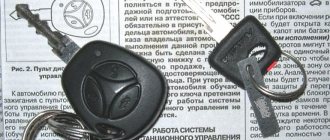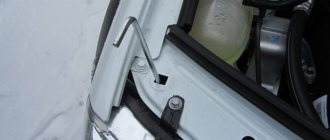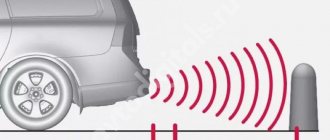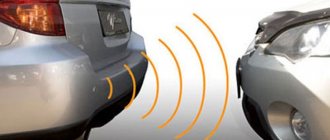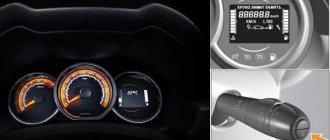Standard devices
The standard parking radar kit for Largus Cross includes:
- 4 sensors with wires and connectors;
- Control block;
- LED indicator for displaying information;
- power wires;
- cutter for making holes;
- installation guide.
More functional and expensive devices may additionally include 4 sensors for installation in the front bumper. The transmission of information in such safe parking systems can be transmitted both by wire and by radio.
Some standard kits do not have a display. In such cases, the parking sensor warns the driver about the presence of an obstacle with an audible signal. The pulse frequency increases as you approach the obstacle. Parking sensors with a beeper are easy to install, since there is no need to lay wires to the indicating device. The speaker is mounted either on the ceiling near the rear row of seats or on the inside of the loading door.
Some models of parking radars are equipped with an information indicator with the ability to mirror the readings. They can be installed on the interior mirror or on the ceiling in the rear of the car. In this case, the driver reads the information by looking in the mirror. The indicating indicator on Largus Cross is built into the console and is equipped with a visual and audio alarm. The display shows graphic information about the side of the obstacle and the distance to it.
Anti-theft system BLACK BUG BT-82L Standard
price from: 10350 i
- Description
Anti-theft system Black Bug BT-82 is designed to protect your car from theft and seizure. A high level of protection against theft is provided by the remotely controlled relay HOOK-DZ or WAIT-D.
Purpose and principle of operation
Black Bug 82 was developed specifically at the request of insurance companies; installation of the system provides additional benefits for CASCO insurance with Ingosstrakh. In accordance with the current agreement with Ingosstrakh Insurance Company, clients are provided with a discount of up to 70% on the theft risk. The risk rate for “Theft” in this case does not exceed 1%. The specified discount applies to both new cars and used cars, and is also provided for re-insurance, provided that the VT-82 system is installed on the car.
System operation
The system uses transponder technology to identify the car owner. To control the system, no action is required from the car owner. You just need to have an electronic transponder tag with you, by which the system recognizes the owner of the car. Each time after turning on the ignition, BLACK BUG BT-82 begins to search for a tag and, if it is successfully identified, disables the engine blocking. After stopping the car and turning off the ignition, after 3 seconds the engine lock is activated, and after 20 seconds the condition of the hood is checked: if the hood is closed, the hood lock is locked; If the hood is open, locking is not performed. Then the system automatically switches to energy saving mode and is in the “ignition off, engine locked, hood lock locked” state until the next time the ignition is turned on.
Anti-theft protection
A high level of protection against theft is provided by the remotely controlled HOOK-DZ or WAIT-D relay, as well as the HOOK-HLD relay specially designed for the hood lock (depending on the configuration). This electronic anti-theft device, made in the housing of a standard car relay, is secretly installed in the car and blocks engine operation in the event of an attempted theft. To control the anti-theft device, dynamic coding is used, which eliminates the possibility of reusing signals to disable the engine lock. The transmission of dynamic signals from the system control unit to the anti-theft relays is carried out via the vehicle’s standard electrical wiring. This ensures increased secrecy of the installation, since the system components are not interconnected by additional wires. It is impossible to detect the HOOK-DZ or WAIT-D relay using diagnostic equipment, since all blocked circuits are closed on a stationary machine. They open only when there is an attempt to steal and the car starts to move. As soon as the car stops, all circuits will be closed again. When the theft is attempted again, the same thing happens. The signal for blocking the WAIT-D relay is the movement of the vehicle in space. The motion sensor is located directly in the anti-theft relay housing, which allows it to make an independent decision to block the engine. The HOOK-DZ relay blocks engine operation after 6 seconds. Even if the thief removes the system control unit, the engine will be blocked.
Protection against user errors
It is known that the notorious human factor often nullifies even the most cutting-edge security technologies. That is why the BLACK BUG BT-82 system has protection for changing any settings recommended by the manufacturer and the insurance company. There is also no Valet mode, which allows you to temporarily disable the system (usually this mode is activated in case of loss of a tag or for vehicle maintenance). There are cases when careless owners simply forgot to take the system out of this mode, leaving the car unprotected. You should not discount the possibility of selecting a secret code with which to launch such a mode. Here we can also add the fact that many owners use the most primitive combinations and even cannot keep them secret. The only way to avoid this is to eliminate the possibility of shutting down the system. If the car is handed over to a car repair shop, it is not necessary to disable the anti-theft system, since it does not interfere with the operation of standard electrical equipment. The car owner simply leaves the tag to the service center staff and then picks it up when the car is accepted. It is important to note here that the system uses DID (dynamic identification dialogue) technology, which eliminates the possibility of making an “electronic impression” from a transponder tag.
Which model to choose
The best selling kit is Spark 8M. The optimal number of sensors with a diameter of 18 mm allows you to detect an obstacle at a distance of 2.5 m and stop 10 cm from it. The device has a high signal processing speed (0.15 seconds), which makes it possible to record changes in distance every 1 cm. The device has an initial learning function that minimizes the number of false positives. During operation, the device performs self-diagnosis and reports problems with an audible signal.
Parktronic ParkMaster 4-DJ-92, in addition to sensors, includes a rear view camera. The equipment is connected to the standard head unit, since the package does not include a display. The device has a voice notification function about detected obstacles and the distance to them. The high reliability of the device made it popular among car owners.
Universal towbar coordination unit (TSU)
- RUB 1,990
- Description
- Reviews (0)
- Question answer
- Cost of delivery
The SMART Connect module is used to control the external lighting of a device paired with the vehicle, connected via the trailer hitch socket, without significant load on the vehicle's main network. Use and operation is possible only on vehicles with negative grounding to the vehicle body (ground), a nominal battery voltage of 12 Volts and an on-board voltage of 9 to 15 Volts.
The electrical coordination unit for the towbar and the vehicle is necessary when installing the towbar on modern cars equipped with new electronic systems to improve the comfort and safety of drivers (ABS, TSP, ESP, etc.).
In vehicles equipped with such systems, directly connecting a conventional socket to the trailer hitch will damage the vehicle. Installing a Smart Connect matching block eliminates additional load on the vehicle's electrical network and stabilizes the network voltage. The connector is resistant to voltage surges and short circuits, as it connects directly to the car battery through a 15 A fuse.
How to find out the cost of delivery of goods? Very simple!
Place all the desired items in your cart (via the green “Add to cart” button) and click the “Place an order” button.
On the ordering page, enter your exact address, after which the site will show all possible delivery methods with prices and terms.
The cost of delivery by Russian Post starts from 180 rubles, depending on your address, the weight of the parcel and its cost.
The cost of delivery by transport companies starts from 200 rubles, depending on your address and the dimensions of the parcel.
We recommend watching
Towbar (tow hitch) for Lada Vesta with installation kit. Towbar hook..
Towbar (tow hitch) for Lada XRAY with installation kit. Towbar hook (..
New items
Set of winter plugs for Lada Granta (sedan and liftback from 2015 to 2022, except Grant FL). The set consists of 2 parts..
Set of rear head restraints for Lada Granta cars (sedan, liftback). Includes 3 headrests. The headrests have 2...
How to install
Parking radar sensors are installed in the rear bumper. Work can be carried out without dismantling the body part. To properly install the parking kit on Largus, you must adhere to the following requirements:
- The distance between the sensors should be equal to 1/4 of the width of the vehicle, measured at the location of the most protruding body parts.
- Install the sensors on both sides of the middle of the bumper.
- The height of the location from the road surface should be 0.6-0.7 m.
Failure to follow the placement order may result in a malfunction of the control unit.
The sensor wires are assembled into a bundle and secured with ties inside the bumper. The cable is inserted into the trunk through the existing hole. The connectors are connected to the control unit. The kit receives power when reverse gear is engaged, which is indicated by a short signal. Parking sensors, correctly installed on Largus with your own hands, will make parking safer.
Lada cars with galvanized body
There is no specific data on the number of elements that have been galvanized and the domestic plant does not issue them. According to various media reports, Lada cars have the following levels of galvanization:
- VAZ-2110 - 31%;
- Niva 2121/2131, Lada 4X4 - no galvanized elements, cataphoretic priming;
- Kalina 1 - 51%;
- Kalina 2 - galvanized body, not counting the roof, hood, side members front and rear;
- Priora - samples from August 2008 - 28%, from next year - full galvanization;
- Largus - There are galvanized parts, but which ones specifically are not clear;
- Vesta - the outer layer of the body is entirely galvanized (sedans - the roof is not galvanized), the station wagon is completely galvanized, the sills and bottom have anti-gravel protection;
- XRay - all parts of the body are galvanized, except the roof.ADA Vesta
How to connect and test
Power is supplied from the reversing light chip. If the display is installed on a dashboard or interior mirror, then the connecting harness is pulled along the floor of the car and raised along the A-pillar to the monitor. If the indicator is installed on the ceiling near the loading door or a beeper is used, there is no need to lay wires throughout the cabin.
After installation, the kit is checked for functionality. When the transmission is on, an object is brought to the sensors one by one until a signal appears. After this, measure the distance to the nearest sensor that detected the obstacle. The resulting value will be the boundary of the sensitivity zone.
If the parking sensors do not respond to the presence of objects in the work area, it is necessary to determine which element has failed. To do this, with the power on, lightly touch the sensor emitter. A working element produces clicks that can be felt by your finger. A malfunction may also appear in the connecting wires. Therefore, there is no need to rush to throw away the sensor without checking the integrity of the lines.
The functionality of the unit is checked by connecting a known-good sensor. If the kit reacts to objects, then the unit is working. Defective elements must be replaced as soon as possible, since the efficiency of the system is reduced, which can negatively affect parking results.
Hi all. This post will be purely technical - no beautiful photos against the backdrop of nature or anything like that. Let me start by saying that yesterday and this evening, after servicing all clients, I was installing rear parking sensors. It's a cheap thing, but it has a lot of benefits. Moreover, on Largus this is 1000 times more relevant - the sirloin is oh so far from the driver’s eye. ))) Buying a rear view camera is not financially feasible for me - those who follow the life of my family will understand. I installed the parking sensors, purchased in China, when I was still taking the girls and was with them for a month. Do you know how much you bought it for? 200 rubles! I get goosebumps when people pay 5,000 wooden ones to install such a miracle. Horror.
In general, all the wires fit on the right side of the body, under the plastic trim of the rear pillar. The control unit is located in the corner behind the belt - it is not noticeable and at the same time accessible. I drilled a bumper for the first time in my life - “honestly, I missed something” the first time, but then everything went like clockwork. By the way, the drill came included! Okay, I tried to take a lot of photos and make it clear. I won't draw a lot of text. In case anyone has any questions, I will be happy to answer. In the wiring block there is a positive reverse wire in the middle - it can be any color except black.
Now the second little thing - from the moment of purchase I was annoyed by the asymmetry of Larik’s butt, i.e. presence of a red fog light spot on the left side. Within 5 minutes this problem was corrected by removing the flashlight and removing the cap from it. A little effort and it's in your hands. No piercing or cutting. Thanks to its shape, it only comes out one way, so if it doesn’t work, twist it. Now, when there is a lack of light, we turn on the fog and everything is ok. In fog, in my opinion, it is more effective to turn on the emergency lights.
These are the pleasant little things that I once again post for your consideration. I hope that b/w is interesting and only beneficial.
I'm looking forward to the return of my girls from China, but another 2.5 months is the gap that we will cross!
Installation can be carried out in two ways - by removing the bumper and without removing it. It is best to remove the bumper during installation. Even though the work will become more labor-intensive, you will still have access to the most remote places and will be able to do everything efficiently.
We buy a set of parking sensors in the store, go home and read the attached instructions.
We are not in a hurry to start installation; we need to understand all the intricacies of the upcoming work. Then we check the functionality of the parking sensors using a 12-volt rectifier. We make markings at the installation site. The distance must be selected correctly, otherwise blind spots may appear.
The bumper has a rounded shape, so the first marking will be applied 10 centimeters from the edge of the surface. It is not difficult to find the middle of a car's bumper because there are dotted bumps on the bumper. We count their total number and divide by two.
Attention! In the inner part of the Largus bumper there are stiffening ribs. When you remove the bumper, all this is clearly visible, but if you don’t remove it, you can end up right there. We make the holes using a special cutter, which is also included in the kit. We park the car over the inspection hole, unscrew its fastenings from the bottom of the bumper. As a result, the outer part of the bumper can be bent a little, and we get a gap. We put the wiring from the sensors there.
In order to make replacing sensors as easy as possible, if necessary, we cut off the wires with a margin of 10 cm. We dismantle the right Largus rear light. We take a good look at the installation site of the optics. Unfortunately, there are no technological holes through which the wires could be inserted; you will have to drill them yourself.
The diameter of the hole is 16 centimeters. In the gap that remains between the bumper and the body, we hide all the wiring and pull it out.
We insert the cords using wire, and eventually they end up in the luggage compartment. Tighten the bumper fastenings. Now you need to connect the rear lights to the wiring. The black wire is ground, the orange one is for reverse. It won't hurt if you have an indicator with you; you can use it to check on the spot.
Carefully cut off the insulation of the wire, without biting it off, attach it there and wrap it with electrical tape.
By the way, before you start working, you must disconnect the negative terminal of the battery, otherwise a short circuit may occur. We put the lantern in its regular place. If the holes for the wiring were chosen poorly, then the lantern will not fit into place, you will have to drill new ones. If everything is in order, then connect the sensors and enjoy the result.
In this case, the distance was chosen incorrectly; between the sensors it should be 52 centimeters. Accordingly, blind spots have appeared, and the outer sensors begin to squeak when they see obstacles that are clearly visible in the rearview mirror. This is what haste means.
Source
Good day to all readers of this wonderful resource! After the first trips after the purchase in Largus, I immediately realized that it is very, very necessary to equip your car with parking sensors or, as they are also called, parking sensors. The budget for this business was small, 700-1200 rubles. I looked at the prices offered by Internet sites and was upset, but for installation I have to pay another 3,000 to 5,000 rubles. I started looking for reviews about installing and purchasing parking sensors on the Lada Largus and found a lot of reports on Drive and the most important thing is that the parking sensors themselves are from China and the price for them is very fair, although I myself ordered a lot of things there, but somehow for the car I didn’t even think of ordering it. I chose parking sensors with a display, I went to Ali and ordered it. He came to me within 14 days, which surprised me very much (quickly). I ordered it here from this seller; at that time it was the cheapest (990 rubles).
Moreover, I want to say that I decided to intervene in the design of a car for the first time; before that I had never had such experience on any of my cars. According to the reports on the installation on the Lada Largus, I couldn’t find parking sensors anywhere according to the step-by-step installation diagram. Everything is somehow in fragments and at the end, and now the miracle is already in the bumper! I think I’ll correct this point and try to describe the whole process step by step myself and post it on the drive website. I'm posting it (don't judge too harshly). So I armed myself with: 1. A set of torx screwdrivers; 2. Pliers; 3. A screwdriver (the hole attachment was included with the parking sensors); 4. Aluminum wire no less than 1.5 m long; 5. Plastic clamp 6. Flashlight; 7. Paper tape; 8. Marker; 8. Roulette. For myself, I clearly determined that I really don’t want to remove the bumper, although some write that it’s not that difficult. I apologize in advance that there are not enough photos, my hands were not very clean and I didn’t really want to get my camera dirty, although I decided for myself that I would take photos of all the stages. I started: 1. I removed the right rear headlight. We remove the right mesh in the trunk and take out everything that was there (jack, wheel wrench, towing hook) from the pocket. I unscrewed two plastic taillight holders from the interior.
Hi all. This post will be purely technical - no beautiful photos against the backdrop of nature or anything like that. Let me start by saying that yesterday and this evening, after servicing all clients, I was installing rear parking sensors. It's a cheap thing, but it has a lot of benefits. Moreover, on Largus this is 1000 times more relevant - the sirloin is oh so far from the driver’s eye. ))) Buying a rear view camera is not financially feasible for me - those who follow the life of my family will understand. I installed the parking sensors, purchased in China, when I was still taking the girls and was with them for a month. Do you know how much you bought it for? 200 rubles! I get goosebumps when people pay 5,000 wooden ones to install such a miracle. Horror.
In general, all the wires fit on the right side of the body, under the plastic trim of the rear pillar. The control unit is located in the corner behind the belt - it is not noticeable and at the same time accessible. I drilled a bumper for the first time in my life - “honestly, I missed something” the first time, but then everything went like clockwork. By the way, the drill came included! Okay, I tried to take a lot of photos and make it clear. I won't draw a lot of text. In case anyone has any questions, I will be happy to answer. In the wiring block there is a positive reverse wire in the middle - it can be any color except black.
Now the second little thing - from the moment of purchase I was annoyed by the asymmetry of Larik’s butt, i.e. presence of a red fog light spot on the left side. Within 5 minutes this problem was corrected by removing the flashlight and removing the cap from it. A little effort and it's in your hands. No piercing or cutting. Thanks to its shape, it only comes out one way, so if it doesn’t work, twist it. Now, when there is a lack of light, we turn on the fog and everything is ok. In fog, in my opinion, it is more effective to turn on the emergency lights.
These are the pleasant little things that I once again post for your consideration. I hope that b/w is interesting and only beneficial.
I'm looking forward to the return of my girls from China, but another 2.5 months is the gap that we will cross!
AvtoVAZ decided to equip the Lada Largus with a parking radar (popularly “parking sensors”), but only the “Lux” and “Cross” versions. Other modifications of the car do not have this useful option for a station wagon or van. Let's look at detailed instructions on how to install parking sensors on a Lada Largus yourself.
You will need: buy parking sensors, remove the bumper, prepare tools.
Attention! We mark the places for parking sensors according to the instructions from the kit. Some sensor models do not work correctly at the height indicated in the photo!
We drill holes in the bumper using a drill and a bit that comes with the kit. We fix the sensors in the holes made.
We hide the wires in a corrugation, which we fix with ties to the rear bumper amplifier. We lay the corrugation with the wires into the trunk through the existing holes in the body.
We place the parking sensor control unit in any convenient place in the trunk. You can secure it with double-sided tape, or use self-tapping screws for more secure fastening.
If you decide to place the parking sensor screen on the Lada Largus panel or mirror, then you will have to run the wires from the trunk to the front of the car (under the floor covering). And if you place the display in the trunk near the passenger’s seat belts, then all the wiring will be located only in the rear, and you can observe the sensor signals through the interior mirror.
Let us remind you that the trunk of the Lada Largus can be modified, for example, by making a flat floor.
Due to the fact that the manufacturer installs a standard parking sensor unit in Largus only in Lux and Cross vehicles, the owners of other cars have to do this work themselves. Most often, a set with 4 sensors is used. This is enough for safe parking of the car both during the day and at night.
Tips for motorists
For many car enthusiasts, the appearance of modern cars with parking sensors installed on them is still a novelty. The benefits of this device when operating a car in urban conditions are enormous. Parking in crowded parking lots becomes much easier. However, the novelty of this device frightens drivers of such cars. Many of them do not know how to use this device correctly, how to maintain it, and what to do if even minor problems occur.
A few words about the signs of parking sensor malfunctions
In most cases, failures of such a system occur due to failure of the sensors of this system or broken wires, oxidation of contacts and other similar issues. Much less often, failures occur due to problems with electronic components. One of these signs may be a rather prolonged squeak, for no apparent reason. Most often this happens when the installed sensors of this system are dirty.
Another reason for this phenomenon may be incorrect setting of the sensitivity of the sensor of this system. You can adjust the device yourself; for this, the system has a special trimming resistor. Often for such actions the system may be triggered by individual tall grass or something similar.
A little about troubleshooting such problems
Experts recommend starting the search for problems by thoroughly inspecting the wiring harnesses, their connectors, and the integrity of the sensors. Broken wires need to be connected, it is best to do this by soldering, followed by insulation of the connection point. The dirt that gets on the connector terminals leads to their oxidation. You can get rid of such deposits with rust remover, but not with sandpaper.
Car owners and repairmen note the failure of sensors; destruction often occurs from various objects falling on their lenses. Such devices cannot be repaired; they can only be replaced with new products. You can adjust and install such devices from other car models. Another reason for such failures may be a short circuit in the wiring from the sensors to the electronic control unit.
This can happen when the insulation of these wires cracks, shorting them out and causing the electronics to malfunction. Only restoring damaged insulation will not solve the problem; you need to diagnose and configure the control unit. Moisture getting into the connections also disrupts the operation of the parking sensors system, but after drying, in most cases, its operation is restored.
Parktronic or parking radar is a small device that not only makes parking a car easier. It also ensures road safety by signaling if an obstacle or another vehicle is too close. And if the car’s parking sensors are broken or simply don’t work, then for inexperienced drivers, as well as those who are accustomed to its constant prompts, this can become a real problem.
see also
Comments 23
The wire that goes from the body into the bumper has rotted
Served well for almost 2 years.
Good morning, the standard parking sensors are broken, when you engage reverse gear, one short (squeaking) sound, then a long one for 3 seconds, then one short one. What does it mean? Tell.
My connector in the body has rotted due to salt, it’s very flimsy, it should probably be inside the body, but it’s on the outside
The same tops. I climbed in to look - the left sensor chip was barely holding on. I sprayed the air with WD-40, pushed it into place - and here it is, happiness: it works
Worked with frets. In six months I only changed 1 sensor, and that was because the car was in an accident. Look at the rear wiring harness and parking sensor harness. It is located on the street behind the rear left wheel under the bumper. 99% is oxidized.
Yes, same problem, 2700 mileage, month of operation and the sensor no longer works
Take it to the dealer and let them decide what the squeak is.
Installing parking sensors on Lada Largus
Installation can be carried out in two ways - by removing the bumper and without removing it. It is best to remove the bumper during installation. Even though the work will become more labor-intensive, you will still have access to the most remote places and will be able to do everything efficiently.
We buy a set of parking sensors in the store, go home and read the attached instructions.
We are not in a hurry to start installation; we need to understand all the intricacies of the upcoming work. Then we check the functionality of the parking sensors using a 12-volt rectifier. We make markings at the installation site. The distance must be selected correctly, otherwise blind spots may appear.
The bumper has a rounded shape, so the first marking will be applied 10 centimeters from the edge of the surface. It is not difficult to find the middle of a car's bumper because there are dotted bumps on the bumper. We count their total number and divide by two.
Attention! In the inner part of the Largus bumper there are stiffening ribs. When you remove the bumper, all this is clearly visible, but if you don’t remove it, you can end up right there. We make the holes using a special cutter, which is also included in the kit. We park the car over the inspection hole, unscrew its fastenings from the bottom of the bumper. As a result, the outer part of the bumper can be bent a little, and we get a gap. We put the wiring from the sensors there.
In order to make replacing sensors as easy as possible, if necessary, we cut off the wires with a margin of 10 cm. We dismantle the right Largus rear light. We take a good look at the installation site of the optics. Unfortunately, there are no technological holes through which the wires could be inserted; you will have to drill them yourself.
The diameter of the hole is 16 centimeters. In the gap that remains between the bumper and the body, we hide all the wiring and pull it out.
We insert the cords using wire, and eventually they end up in the luggage compartment. Tighten the bumper fastenings. Now you need to connect the rear lights to the wiring. The black wire is ground, the orange one is for reverse. It won't hurt if you have an indicator with you; you can use it to check on the spot.
Carefully cut off the insulation of the wire, without biting it off, attach it there and wrap it with electrical tape.
By the way, before you start working, you must disconnect the negative terminal of the battery, otherwise a short circuit may occur. We put the lantern in its regular place. If the holes for the wiring were chosen poorly, then the lantern will not fit into place, you will have to drill new ones. If everything is in order, then connect the sensors and enjoy the result.
In this case, the distance was chosen incorrectly; between the sensors it should be 52 centimeters. Accordingly, blind spots have appeared, and the outer sensors begin to squeak when they see obstacles that are clearly visible in the rearview mirror. This is what haste means.
Source
Kaleidoscope:
Refinement of the stove motor
This part, probably, would have been better called “Refinement of the heater motor activation mode”, since we will be talking specifically about eliminating a kind of “bug” - the operation of the interior heater when the ignition key is turned to the ACC position.
Indeed, the functionality of the interior heating system is in big question when the “stove” motor is turned on and the engine is not running - there is no circulation of coolant, and the coolant in the “stove” will quickly cool down and stop heating the interior.
The interior heating system of the Lada Largus can be modified in several ways
For Largus owners, there are two ways to change the operating mode of the heater motor. And both, unfortunately, require intervention in the electrical circuit of the car.
First
The first way to change the operating mode of the interior heater simultaneously with turning on the ignition is to move the wire that controls the heater relay from its standard location to any terminal that receives + 12V when the ignition is turned on. This could be, for example, a reverse switch or a fuel pump relay. That is, the thin yellow wire going to the “stove” motor relay is cut off and connected to any of the above locations.
For reference: all of the above actions are performed in the relay and fuse box located under the hood. The heater motor is controlled by a yellow wire, the reverse switch is controlled by a wire of a similar color, and the fuel pump has a beige marking.
Second
Almost similar to the first one, but the difference is that after all the manipulations we get a free fuse socket.
Again, we cut the thin conductor of the heater motor and connect it to the partially stripped yellow wire located nearby. After that, all damaged areas are isolated and fuse No. 39 in the interior fuse box is removed.
DIY parking sensor repair
Repairing parking sensors with your own hands is, in principle, a simple matter under one condition - you must understand and know what you are doing. Otherwise, it is better not to act on your own and contact the service. It will be cheaper. This is especially true for repairing the electronic circuit of the control unit. If you installed the parking sensors with your own hands, then you will not have any problems with the “ringing” of the wiring.
But most often problems occur with parking sensors. And one of them is the parking sensors constantly beeping. According to the rules, the parking sensor is activated when reverse gear is engaged. If, while moving forward, a constant operation occurs and the sensor beeps, then there are two options: either a short circuit occurs in the circuit, or a foreign body has stuck to the sensor: dirt, a piece of ice, the body of a dead insect.
The parking sensor is a delicate creature, and the most common reason for the constant operation of the system is water. Especially in the cold season, after washing. After drying the sensor, the squeak disappears. If not, then you need to diagnose the sensor.
How to check the parking sensor if the indicator does not show an obstacle, but it actually exists. Or rather, how to figure out which sensor is not working. Diagnostics of the sensors is simple: close the sensors one by one, and an assistant watches the indicator readings in the cabin.
Basic faults
Parking sensors are in direct contact with the external environment, so the cause of most breakdowns will come from outside. The sensors are designed to help the driver assess the distance to the nearest objects behind them - therefore damage to the parking sensors is unlikely due to an impact. However, this happens more often than failure of the wiring or system control unit.
The main reason for the failure of Vesta’s parking sensors is simple dirt. The system itself will report the existing problem. You will hear a loud, long, continuous tone followed by a series of short beeps indicating the following:
- one short signal – the left parking sensor is faulty;
- two short beeps – center left;
- three high-pitched sounds – the central right parking sensor is broken;
- four – respectively right;
- Five beeps indicate problems in the control unit.
After this, the system turns off. You can try to clean the parking sensors with a soft cloth (in no case using sharp objects) and try to put the Vesta parking sensors back into operation. Usually, the system starts to operate in normal mode. If this does not happen, contact service or find the problem yourself. It could be:
- current leakage in the system, poor contact along the wire harness;
- the parking sensor control unit is broken;
- alarm unit is broken;
- sensor is damaged.
Parktronic Lada Largus installation
Hello everyone, exactly a year ago I installed parking sensors on my Logan, after traveling I realized how convenient it is, by the way I installed some of the cheapest parking sensors, so I’ve been watching this Chinese miracle for a year, they work. At first there was a thought that in winter they might not show correctly, but I was pleasantly surprised that they work properly and do not cause any complaints.
Today the weather is rainy, after working in the morning I got some free time, went to the garage to install it, my hands were itching)
Included: 1. 4 parking sensors (with a very long wire) 2. power cable with chip 3. module itself 4. screen with beeper
Having prepared the place, the heat rushed)
I took a 20 mm drill, but the size of the parking sensors itself is about 21 mm, I did not modify the hole much with sandpaper.
let's go stretch the wire and figure out what's what)
under the screw hole there was a small plastic plug in the body, behind it there was a nightmare, I didn’t take pictures of these details, but I think a photo from the internet will be fine)
I made holes in this gap and drove the entire bundle of 4 wires through.
Once everything was ready in terms of pulling the wires into the interior, I covered the distance between the wires with sealant.
Next we climb into the salon to see what to connect where)
according to the count on the chip itself it will be written from 1 to 6, we need a brown wire, . by numbering 3.
secured the whole thing with two clamps) and glued it with a soft sponge so that it would not rattle or heat on the body
That's all with the luggage compartment, let's go to the salon to look for a convenient place to install the screen, I made it for myself)
I disassembled the screen itself and turned over the board with the screen, because I wanted to install it on the ceiling, but initially it was designed for installation on a panel)
I didn’t want to spoil it and glue it (collective farm directly onto the ceiling itself, I made a kind of clamp for the ceiling from an old bank card
Replacing the parking sensor
Another common cause of parking sensor malfunction is mechanical damage to the sensor mirror by a small stone, which, according to the “sandwich law,” falls precisely in the center of the sensor. There are two options here: contact the service, where you will hear the cost of a standard parking sensor, which will include delivery of the sensor from the USA, bonuses for the entire delivery department and a modest price for the sensor itself.
The second option is to buy a sensor that is suitable in size and operating parameters and install it instead of the standard one. In this case, if the replacement sensor is of a different color, then painting the parking sensors, which you can do yourself, can easily improve the situation. The body of the new sensor is degreased and coated with a thin layer of varnish of the color you require.
Basically, we have listed the “folk” methods and methods by which the parking sensor is repaired. The most effective way is to contact a specialized service, naturally at a reasonable cost of repair.
Installing parking sensors on Largus with your own hands
Hi all. This post will be purely technical - no beautiful photos against the backdrop of nature or anything like that. Let me start by saying that yesterday and this evening, after servicing all clients, I was installing rear parking sensors. It's a cheap thing, but it has a lot of benefits. Moreover, on Largus this is 1000 times more relevant - the sirloin is oh so far from the driver’s eye. ))) Buying a rear view camera is not financially feasible for me - those who follow the life of my family will understand. I installed the parking sensors, purchased in China, when I was still taking the girls and was with them for a month. Do you know how much you bought it for? 200 rubles! I get goosebumps when people pay 5,000 wooden ones to install such a miracle. Horror.
In general, all the wires fit on the right side of the body, under the plastic trim of the rear pillar. The control unit is located in the corner behind the belt - it is not noticeable and at the same time accessible. I drilled a bumper for the first time in my life - “honestly, I missed something” the first time, but then everything went like clockwork. By the way, the drill came included! Okay, I tried to take a lot of photos and make it clear. I won't draw a lot of text. In case anyone has any questions, I will be happy to answer. In the wiring block there is a positive reverse wire in the middle - it can be any color except black.
Now the second little thing - from the moment of purchase I was annoyed by the asymmetry of Larik’s butt, i.e. presence of a red fog light spot on the left side. Within 5 minutes this problem was corrected by removing the flashlight and removing the cap from it. A little effort and it's in your hands. No piercing or cutting. Thanks to its shape, it only comes out one way, so if it doesn’t work, twist it. Now, when there is a lack of light, we turn on the fog and everything is ok. In fog, in my opinion, it is more effective to turn on the emergency lights.
Standard devices
The standard parking radar kit for Largus Cross includes:
- 4 sensors with wires and connectors;
- Control block;
- LED indicator for displaying information;
- power wires;
- cutter for making holes;
- installation guide.
More functional and expensive devices may additionally include 4 sensors for installation in the front bumper. The transmission of information in such safe parking systems can be transmitted both by wire and by radio.
Some standard kits do not have a display. In such cases, the parking sensor warns the driver about the presence of an obstacle with an audible signal. The pulse frequency increases as you approach the obstacle. Parking sensors with a beeper are easy to install, since there is no need to lay wires to the indicating device. The speaker is mounted either on the ceiling near the rear row of seats or on the inside of the loading door.
Some models of parking radars are equipped with an information indicator with the ability to mirror the readings. They can be installed on the interior mirror or on the ceiling in the rear of the car. In this case, the driver reads the information by looking in the mirror. The indicating indicator on Largus Cross is built into the console and is equipped with a visual and audio alarm. The display shows graphic information about the side of the obstacle and the distance to it.
TOWER / REMOVABLE SQUARE / LADA LARGUS C 2012
- Description
- Characteristics
- Benefits
- Reviews 2
A towing device (towbar) with a removable square for a LADA Largus passenger car is used for towing trailers with a car (tractor). The PT GROUP company produces towbars, the installation of which uses the maximum possible number of standard (provided by the automaker) attachment points, which allows you to optimally distribute the load on the car body. Manufacturer: PT GROUP Car make: LADA Car model: LARGUS, LARGUS CROSS Year of car production: 2012, 2013, 2014, 2015, 2016, 2022, 2018 Functionality: The towbar is designed for towing trailers with a car Material: Steel (PPK) Weight: 13 kg Maximum towing force: 1300 kg Brand: Lada A square towbar or, as it is also called, an American towbar on the LADA Largus, is very easy to use, thanks to the quick-release part, while the towbar frame and bracket are hidden behind the rear bumper and do not protrude beyond the dimensions of the car . In our online store you can buy a tow bar for an American square, the frame of which is installed in the standard places provided by the manufacturer. The outlet from the frame is a thick-walled pipe with a square cross-section and a through hole for the locking pin of the towbar. The diameter of the ball is 50 mm.
Advantages of the quick-release towbar “American square” produced by PT GROUP
- The trailer hitch (towbar) / removable square is installed in the standard places of the car provided by the manufacturer.
- The hitch ball is made of stainless materials and has a presentable appearance even after several years of use;
- Unique multi-layer painting technology;
- Only galvanized hardware is used in the complete set of products.
Advantages of the tow bar design: removable square
- It takes no more than 10 seconds to remove/install the traction bracket;
- No special tools required for removal/installation;
- In the main unit it is possible to use other products with a “square” fastening;
- The ability to adjust the horizontal level of the hitch within the lowering of the tow bar by turning the removable bracket over;
- Possibility to replace both the entire removable bracket and the tow ball separately
Material
The towbar is made of high-strength steel ST3. The metal is powder coated.
Installation of trailer hitch (towbar) on LADA Largus
You can install the tow bar yourself; it is important to carry out the installation strictly following the detailed instructions for the product.
Equipment
The trailer hitch is equipped with everything necessary for installation on a vehicle. A complete list of parts is provided in the installation instructions. Attention! The electrical kit is not included in the towbar package. It is purchased separately.
Which model to choose
The operating principle of parking sensors is based on the reflection of an ultrasonic signal from an obstacle and its reception by the sensor. Their number determines the size of the controlled area. The more sensors, the fewer blind spots behind the car. Due to the fact that the power of the emitters is low, the parking sensors can detect an obstacle at a distance of 2-2.5 m. The change in the distance to an object for different models is fixed from 1 to 10 cm, and the minimum operating distance of the radar is 10-30 cm. The characteristics and quality of parking sensors depend on the manufacturer.
Engine range
Largus was initially equipped with Renault 8 and 16-valve engines - K7M and K4M. At the moment, these engines are no longer available; there are configurations only with VAZ power units.
For X Ray Cross there are 2 engine options:
- The Nissan H4M engine, also known as HR16DE, with a power of 113 hp is installed with the Jatko variator. With.
- There will also be configurations with a 1.8-liter VAZ engine producing 122 hp. With.
There are 2 engine options available for the Lada Vesta:
- Vazovsky 1.6 l, 106 l. With.
- 1.8 for 122 l. With.
- Nissan N4M.
There are 3 engine options for the Lada Granta:
- VAZ 8-valve.
- 16-valve.
- Paired with a Japanese automatic transmission, the Priorovsky 126 engine produces 98 hp. With.
Now all VAZ engines are equipped with a plugless piston. The wells in the pistons are designed for the full stroke of the valve, which eliminates the possibility of its deformation if the timing belt breaks. I consider this a significant advantage.

